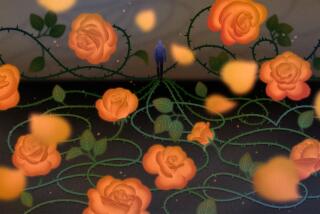Essays That Show How Accepting Failure Can Add to Our Strength
LEARNING TO FALL
The Blessings of an Imperfect Life
By Philip Simmons
Bantam
176 pages, $16.95
*
It’s a spiritual truth reflecting on much in life: We must learn to fall if we’re ever going to walk. As toddlers, tripping is part of the deal as we try to balance our ungraceful bodies on stubby legs and take our first steps. All risky enterprises require falls of some sort. Author Philip Simmons, in his collection of life-affirming essays “Learning to Fall,” recognizes this truth. He writes with clarity about the many ways we topple--both spiritually and physically, sometimes with invigorating awe, more often with terrifying speed.
In sports, martial arts, dancing and rock climbing, Simmons writes, we learn to fall bodily. Falling in and out of love is more metaphorical, but involves the same sense of letting go and tumbling. As we age, we fall from vigor into frailty and illness. Ultimately, we will all take our biggest fall--from life into death. And yet, though every act of falling is an integral part of life, he tells us, “mostly, though, we learn to do it badly.”
Simmons has had to learn to fall, not out of choice, but due to illness. At age 35 he learned he had amyotrophic lateral sclerosis, or Lou Gehrig’s disease, a fatal condition that has robbed him of much of his physical competence. Confined to a wheelchair and having difficulty speaking, he lives in the shadow of the New Hampshire mountains he used to love climbing, and reflects on the tenuous quality of life. In 12 essays, he meditates on the change of seasons and what the physical world tells us of the human condition; his nature writing is crystalline, exuding a vivid and incisive sensitivity to his surroundings.
He also considers his transformation caused by the progressive illness, not solely in light of his own suffering but from a wider perspective: that of the wisdom that’s accumulated over the centuries about physical deterioration, falling and death. Though primarily writing from a Christian orientation, he pulls from a broad range of wisdom traditions to consider his plight, and all of ours.
“This is not a story of triumph over adversity,” he warns readers. “The man chased by tigers does not win in the end, at least not Hollywood fashion. In Christian theology, we fall so that we can rise again later. That’s a good story, too, but not the one I’m telling.” Rather, Simmons’ story focuses on the victory found in falling itself, of rushing headlong into the failings of life, and of realizing that our own vulnerability is “the cost of walking upright on the earth.” (Prior to his illness, Simmons was a professor of English at Lake Forest College in Illinois, and his love for literature fuels his narrative. He quotes aptly from Thoreau, Marcus Aurelius, Aristotle, Descartes, Freud, Sartre--even Woody Allen--on surrendering to life’s imperfections.
“Mine is the mysticism of everyday life,” he writes, “of the heaped laundry and the bruised toe, of overcooked broccoli and leaves spangled with dew, of sunrise and sorrow, laughter and linguine, music and mold.” This mysticism, he tells us, requires no special powers beyond imagination, attention to the ordinary and “a willingness to be surprised by grace.”
Though the book is an easy read, it is not facile in its contemplation of the larger issues. Simmons’ staunch refusal to slip into self-pity is coupled with a sense of humor that enlivens the tale. Commenting on his wife who makes sculptures out of salvaged books, for example: “While ... I’m in my cabin in the woods writing books, she’s in her studio inflicting various tortures upon them, and in this regard you could say we have a perfect marriage.”
Simmons commands us to stop the litany of worries long enough to see the preciousness of each moment. Knowing you’re going to die, he suggests, pushes you to a wildness in life, an open-armed acceptance of all its sundry parts, a willingness to live on the edge.
The type of falling that most interests Simmons is not so much a falling away from, but a falling to: When we fall from ego, from our carefully constructed identities, we are then able to fall into passion, into terror, into humility and into oneness with others who are likewise falling. “We fall, at last, into the presence of the sacred, into godliness, into mystery, into our better, diviner natures.”
More to Read
Sign up for our Book Club newsletter
Get the latest news, events and more from the Los Angeles Times Book Club, and help us get L.A. reading and talking.
You may occasionally receive promotional content from the Los Angeles Times.






